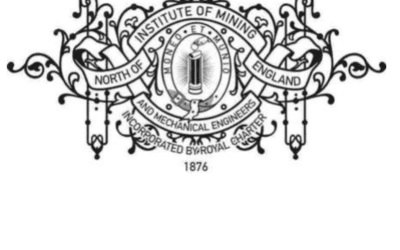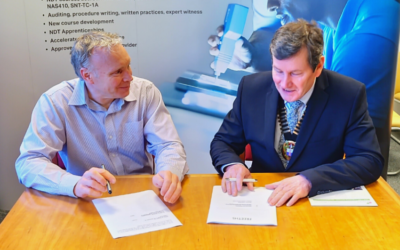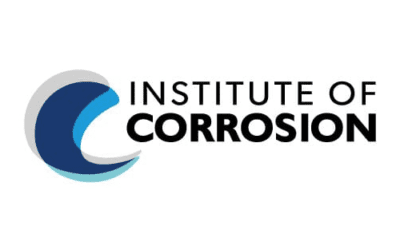The third article in this series from ICorr Fellows who have made a significant contribution in the field of corrosion is by Bill Hedges, Vice President of the Institute of Corrosion, FICorr, FRSC, FNACE and CEng.
Corrosion Monitoring and Inspection
Corrosion monitoring and inspection are essential components of a corrosion management programme and numerous books, papers and conferences are dedicated to these subjects. This article focuses on some key points of these activities and the reader is encouraged to review the literature for more detailed information.
To minimise safety, environmental and business risks whilst maximising reliability, it is essential that equipment is maintained in a condition appropriate for the service required. Equipment in this condition is described as Fit-for-Service (FFS), i.e. the equipment can operate safely under defined operating conditions for a defined operating period. It should be noted that equipment that is FFS does not have to look nice or be corrosion free – although that is often desirable for other reasons! Corrosion is one of many possible degradation mechanisms that can negatively impact the condition of equipment and ultimately render it not FFS. Corrosion monitoring and inspection are used to determine if equipment is FFS and to predict how long it will remain so.
The definitions of corrosion and inspection can become blurred but broadly inspection involves quantifying the safe, usable wall thickness of metallic equipment and identifying defects such as thinning, cracking or pitting, caused by corrosion. Inspection is usually the most accurate way to determine current equipment condition but has the obvious disadvantage that any damage that is detected has already occurred. Inspection is therefore a lagging indicator.
To complement inspection methods, a leading indicator is needed; something that will identify that degradation is occurring and provide enough warning so that an intervention can be implemented well in advance of the problem impacting FFS. In practice a true leading indicator is difficult to obtain but this is what corrosion monitoring strives to do.
For both corrosion monitoring and inspection it is critical that the correct locations are selected. This requires a full understanding of the corrosion threats, the probable corrosion rates and the consequence of failure, i.e. a risk-based approach.
Corrosion Monitoring
Historically corrosion monitoring was exclusively associated with the measurement of corrosion rates. However, this definition has been extended to include the measurement of the performance of corrosion control barriers, e.g. the availability of corrosion inhibitors, the condition of coatings, or the electrical potential of equipment under cathodic protection control.
Corrosion Rate Monitoring
In broad terms corrosion rate monitoring is the measurement of a representative corrosion rate for a given piece of equipment exposed to a corrosive service. There are several techniques that can be used either as standalone or in concert with each other. Ideally corrosion monitoring is designed to provide real time feedback on the corrosion control process. It is important to remember that any given monitoring technique will have limited accuracy and sensitivity, and should be chosen to provide appropriate information. Monitoring is used for corrosion on both internal and external surfaces, but for this article only internal monitoring is discussed. Traditional methods for internal corrosion monitoring include:
i. Mass (weight) Loss Coupons.
ii. Electrical Resistance (ER) Probes.
iii. Electrochemical Monitoring (e.g. linear polarization resistance (LPR),
AC Impedance).
Clearly there is a cost to installing and running corrosion monitoring programmes and this needs to be balanced against the value that they will provide. For probes, the ideal situation is to have them hard wired or wirelessly connected into the equipment control system which is best done during design and construction.
There can be a significant operating cost to manage coupons and probes which obviously depends on the size of the programme. Insertion and retrieval of coupons and probes into pressure containing equipment may present safety risks and must be done by specially trained personnel. Analysis of coupons requires laboratory facilities and the analysis of data requires appropriate training. These contribute to the cost of the programme and so the value of the data must be carefully considered. Monitoring data should never be considered as simply nice to have. If the data are not actively used and acted upon it begs the question of why invest in the expense and effort of installing corrosion monitoring facilities.
Corrosion Barrier Monitoring
To reduce corrosion rates to an acceptable level, corrosion engineers use a variety of mitigation methods known as barriers. These fall into two broad categories as follows:
i. Passive Barriers: these are barriers which require little or no active management during the lifetime of the equipment, e.g. the use of a material that is resistant to corrosion in the specified fluid.
ii. Active Barriers: These are barriers that require active management by corrosion engineers. This can range from periodic visual inspection to monitor the condition of paint coatings to daily adjustment of corrosion inhibitor injection pumps.
It should never be assumed that because a barrier has been installed it will always work as designed. Where active barriers are employed it is essential that their performance is monitored to ensure they continue to perform as designed over the lifetime of the equipment. This is known as corrosion barrier monitoring, i.e. a corrosion monitoring programme is not just about measuring corrosion rates.
A good corrosion management programme will have at least one barrier in place for each credible corrosion threat and each of these barriers should be monitored to ensure they are working as designed.
Inspection
The majority of inspections are carried out using well-established techniques that have been available for many years, i.e. Visual Testing (VT), Ultrasonic Testing (UT), Radiography Testing (RT), Magnetic Particle Testing (MT) and Dye Penetrant Testing (PT).
Many of these techniques have been built into both internal and external tools, e.g. intelligent (smart) pigs, drones and subsea remote operating vehicles (ROVs).
Many inspection instruments are now small enough such that they are truly portable and can be handheld by a single person. Inspection equipment can also be permanently installed on facilities to provide point measurements at known defects or more extensive, circumferential or longitudinal coverage. Another important development is the increased use of remotely controlled crawlers and drones which can carry cameras to locations that are difficult or costly to access, such as subsea pipelines, flare stacks and offshore platform jackets.
An example of a Corrosion Management Dashboard.
An important development in radiography is the widespread use of digital radiography which uses electronic detectors instead of traditional film plates. The resolution of the digital “plates” provides very high-quality images with each pixel offering 250µm resolution. The high sensitivity also allows either lower strength radiation sources to be used or shorter exposure times. In addition, modern data processing provides very fast data acquisition and analysis of images which allows the images to be seen in almost real-time.
Collection and Analysis Data
Following data acquisition by corrosion monitoring and inspection, it is paramount that the data are stored, analysed and interpreted.
Real-time transmission of corrosion data from electrically based monitoring (e.g. ER, LPR, oxygen probes) has been available for many years although it required the installation of hard wiring from the probe to a control centre. In recent years there have been significant advances in the availability and reliability of wireless communications. This has enabled data to be transmitted relatively inexpensively from corrosion monitoring locations in real time.
Many companies provide software that can take multiple data inputs and correlate them with the corrosion monitoring data. As an example, taking temperature, pressure and flow rate data from a pipeline to estimate an unmitigated corrosion rate. These data are then presented in a corrosion dashboard which can be seen at any location around the world. The above figure shows a typical dashboard that displays real time fluid flow rates, velocities, sand rates and estimated corrosion rates.
Future Considerations
Inspection techniques can measure equipment wall thicknesses very accurately but historically they have required skilled technicians to make the measurements using portable equipment. The cost of this has meant that repeat inspections were undertaken at a frequency of 1-5 years. However, with improvements in technology, the use of permanently installed inspection equipment has blurred the boundary between what was traditionally referred to as Inspection and Monitoring, and the use of inspection techniques as ‘real-time’ corrosion monitoring tools has become more common.
These non-intrusive, highly sensitive technologies are able to work through solid external coatings (e.g. FBE, PE, 3LPP). They are increasingly becoming the preferred methods for corrosion monitoring going forward and offer the option to eliminate intrusive monitoring and the risks associated with it.
Guided wave UT is increasingly being used to monitor long lengths of piping and pipelines. It is probable that these techniques will be used to provide close to 100% coverage of equipment to provide real time measurements at all locations. This would be a key step towards intelligent equipment which self identifies problems.
Corrosion monitoring and inspection programmes can generate large volumes of data which are often reviewed in isolation. There have been significant advances in data analytics (so called “Big Data”), artificial intelligence and machine learning. These technologies can rapidly analyse vast quantities of structured (e.g. data) and unstructured (e.g. reports) information to provide insights that may have been missed.
Finally, engineers and technologists continue to find new and improved methods for monitoring and inspection. Perhaps one day corrosion may be eliminated but until then it is certain that better methodologies for monitoring and inspection will continue to appear.



